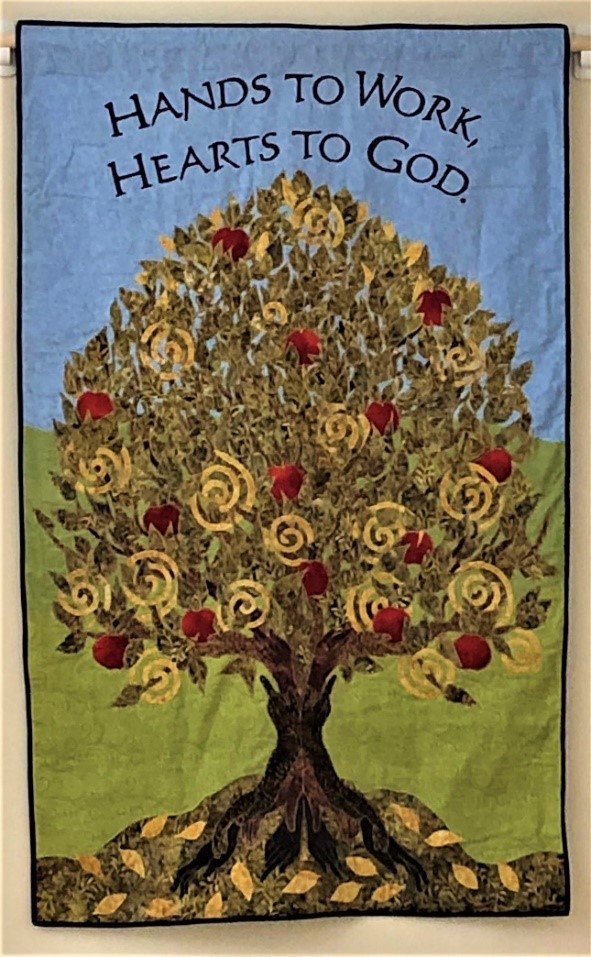
Hanging in the new sanctuary of the Canaan Congregational Church is a colorful fabric banner depicting the Tree of Life, with words across the top that say “Hands To Work, Hearts To God.” I immersed myself in the creation of this Tree of Life banner, which took more than eight hundred hours to design and create. It is a gift expressing my love for God, Life, and our Canaan Congregation.
About eight years ago, the Deacons of the congregation asked me to make a banner for the church. The fruit of that discussion was the Tree of Life idea, with a verbal message from the Shaker tradition. I began work on the banner, but soon was stricken with a serious, rare illness, which sidelined the banner work until relatively recently. With my health much improved, I was able to complete the banner just in time for the dedication of our new worship space. Had I not set the work aside for a time, it could have gone up in flames when our church building burned.
Trees nurture each other as do the members of the church family at Canaan Congregational Church
The Tree of Life has surfaced as an important religious symbol in many traditions, in differing forms, carrying a variety of meanings: love, peace, honoring of ancestors, growth and strength, harmony, family, fertility, wisdom, immortality and rebirth, and a connection to everything. In the Celtic tradition, the Tree of Life is depicted in multiple forms. The roots represent the “otherworld,” the trunk represents the mortal world and connects the roots and branches, and the branches represent the world above, or the heavens. When they cleared their lands, the ancient Celts, who held great reverence for trees, would leave one single tree standing in the middle. They would hold their important gatherings under this tree and it was a very serious crime to cut it down. It represented harmony and balance and was an important symbol in the Celtic culture.
“She (Wisdom) is a Tree of Life to those who take hold of her; those who hold her fast will be blessed.” — Proverbs 3:18 (New International Version)
In the Judeo-Christian tradition, there are several references to the Tree of Life. The first is in the Book of Genesis. It is a tree that grows within the Garden of Eden and is the source of eternal life. In Christianity, some believe it to be the symbol of humanity free from corruption and sin, while others believe it to represent love. The tree is believed to have healing properties, and its fruit grants immortality. Because Islam honors many stories from the Bible, the Tree of Life, which appeared in Eden, is known as the Tree of Immortality in the Quran. Buddhists have the Bodhi Tree, under which the Buddha achieved enlightenment.
The choice of the Tree of Life is of deep meaning to me personally because I have been a tree lover all my life. As a very young child, I used to think that the trees swaying on a windy day were expressing themselves by creating the wind with their dancing movement. My scientist parents promptly disabused me of this notion, but I continued to think of trees as marvelous and very alive beings. Now science is discovering that trees do indeed “communicate” with one another underground, via tiny white strands of fungus in the soil called mycelium: Trees nurture each other as do the members of the church family at Canaan Congregational Church.
